the alta environmental center's annual report on conservation and SUSTAINABILITY efforts.
download the 2022 sustainability report
Underneath Alta’s one-hundred-inch base layer of snowpack lives an entire ecosystem with diverse plant communities and habitats. Alta’s history has its roots in an old mining town that was first established in the 1880s, and the development of the area came at the expense of nearly every tree in Albion basin. Deforestation caused more than just ecological systems loss; it created dangerous avalanche conditions that destroyed the Town of Alta on more than one occasion. Most of the trees you see around Alta have been planted since the 1930s, and almost a hundred years have passed since the beginning of conservation efforts. Due to these efforts, the health of Alta’s forest has improved dramatically. Coming into our 85th season and looking to be around for another 85-plus years, our mission is to conserve Alta appropriately to ensure future generations can enjoy Alta’s magic just as we have. This summer’s work in a snapshot looked like:

THE FULL-CIRCLE PROCESS
As summer begins to fade and warm sunlit mornings turn to shorter and colder days, the Alta Environmental Center begins its annual seed harvesting process. 34 species of seed from shrubs and wildflowers were collected this past fall, all dedicated to Alta’s vegetation management program. Collecting and planting from the environment in which we operate promotes successful revegetation and restoration in areas of disturbance. The elevation, location, date, and species are recorded when harvesting to ensure we plant the seed back into a similar environment. After harvesting the seed, it is sorted, placed in individualized packages, and sent to our local grower – Dryland Horticulture.
Collecting and planting from the environment in which we operate promotes successful revegetation and restoration in areas of disturbance.
Here, the seeds will be grown in a controlled environment throughout the winter until late spring arrives, and the snow-filled mountains begin to melt. We pick up the seedlings and bring them to our nursery which is located here at Alta. Alta Environmental Center staff will tend to the nursery and the seedlings will be planted throughout the summer according to ski area disturbance projects. Harvesting, sorting, growing, and planting these seeds is a full-circle process that takes an entire year to complete. With the help of our partner organizations and community, we have been able to expand and continue our land conservation efforts every year, and we are already looking toward our next summer season and the restoration projects that lie ahead.
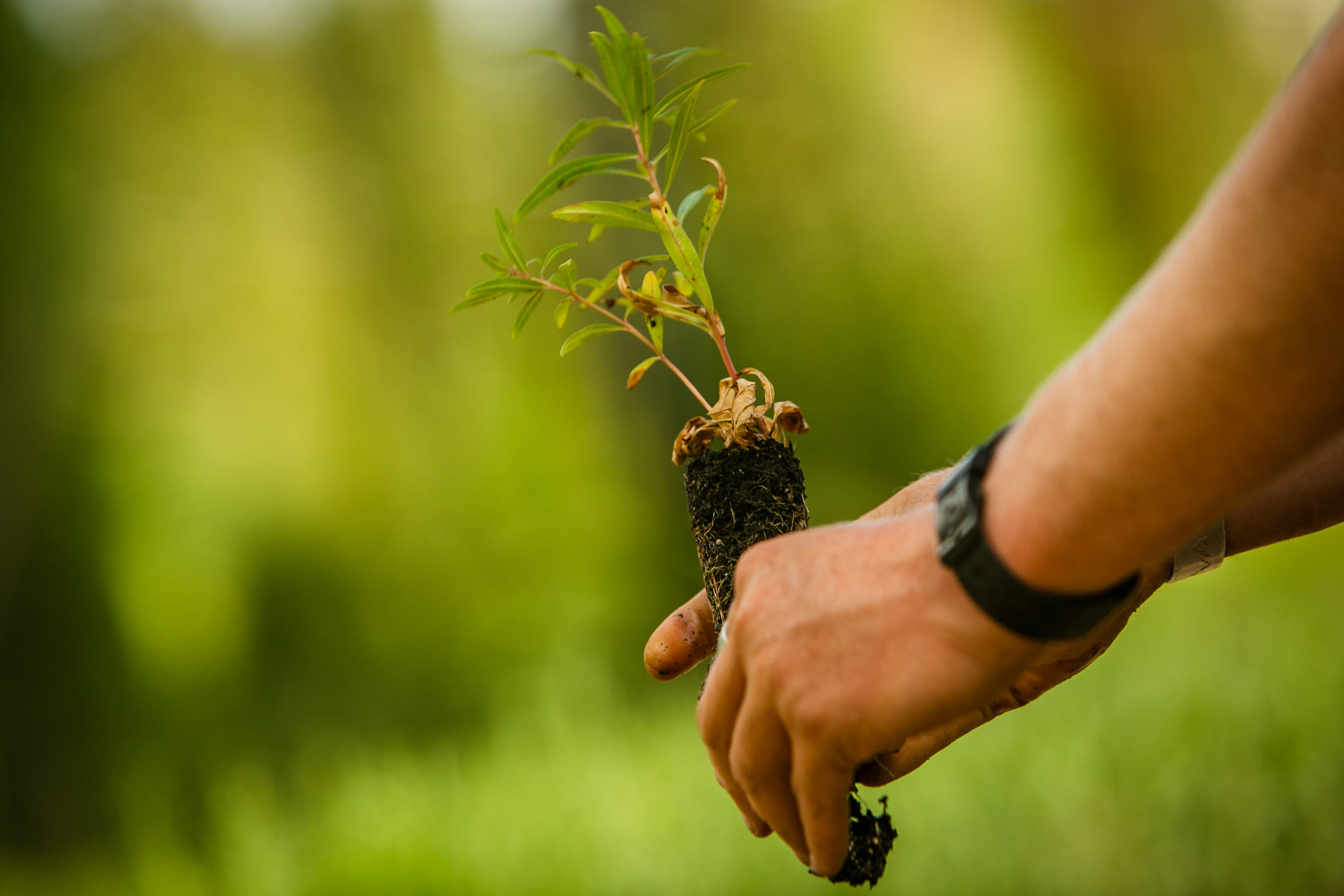
One of many seedlings that were harvested as seed in the fall and grown over winter. | Photo: Rocko Menzyk
WEEDING THOSE PESKY INVASIVES
Another major aspect of our land conservation efforts is the management and mitigation of invasive, non-native, and noxious plant species. Non-native, invasive species can thrive in areas of disturbance and roadsides. This can lead to out-competing native vegetation and reduction of plant diversity – threatening the health and ecological balance of Alta’s environment. The spread of invasive plant species also breaks down soil stability, which can have lasting impacts on the protected watershed by reducing the ability of the soil to absorb and filter water run-off that enters our watershed and flows down canyon to our homes.
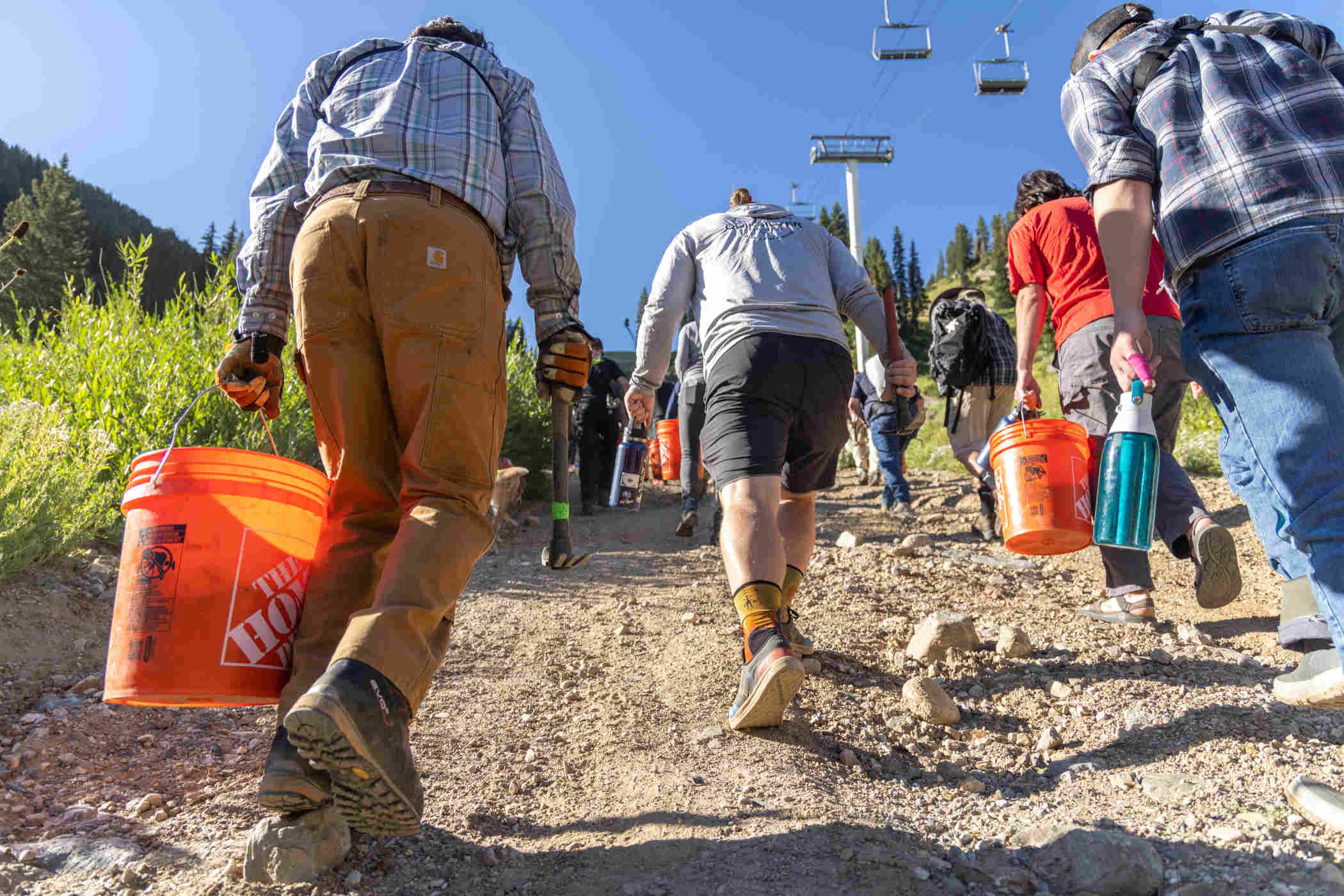
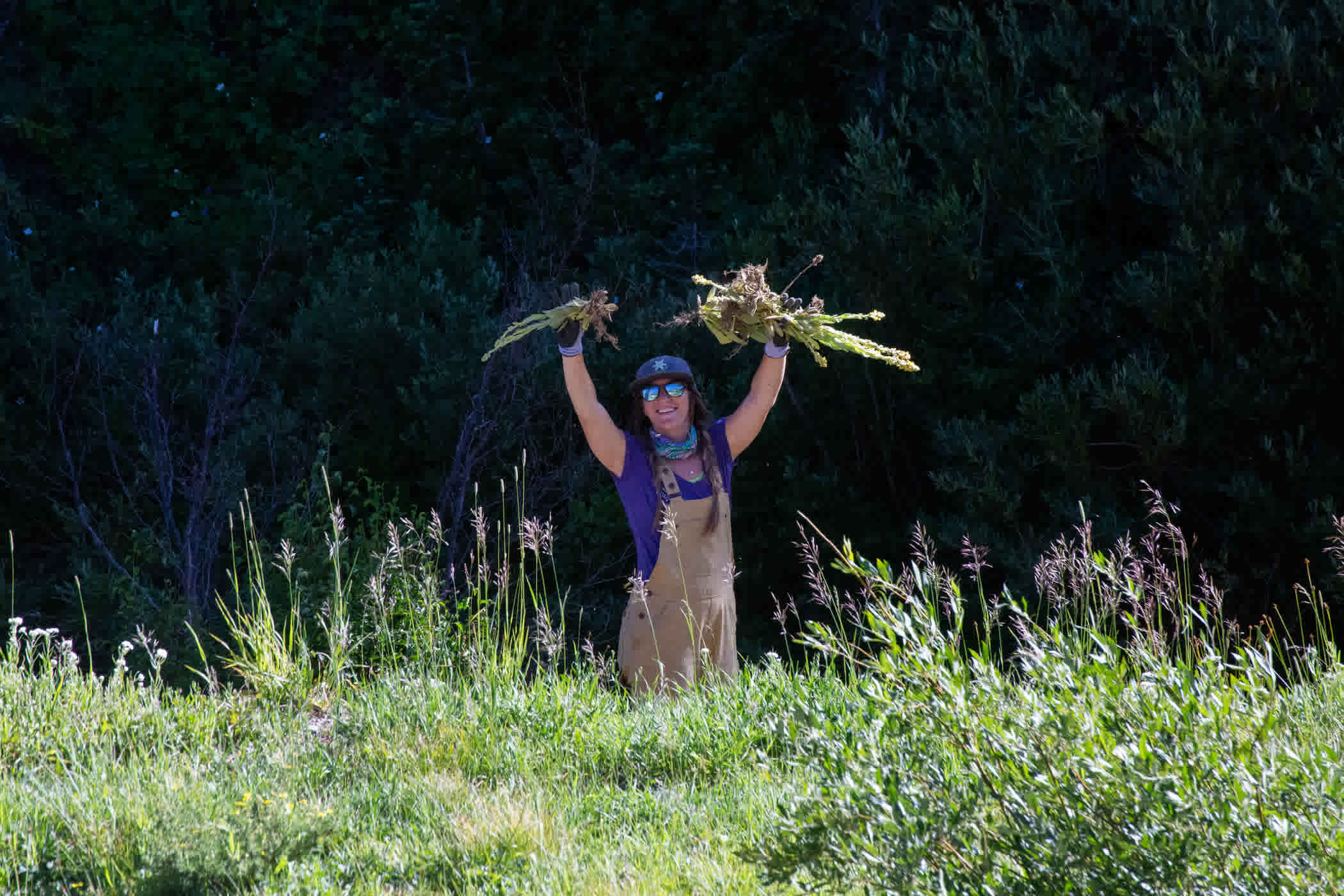
Volunteers helping with revegetation projects around Alta over the summer. | Photo: Rocko Menzyk
In partnership with the Cottonwood Canyons Foundation (CCF) and Friends of Alta (FOA), 101 acres within the ski area and the Town of Alta are surveyed to properly document and remove invasive, non-native plant species. This management helps promote the ecological balance of Alta’s alpine environment and encourages a more sustainable and healthier ecosystem.
NINA'S RESTORATION
The re-grade project on the front-facing ski runs of Nina’s and Schuss were made in the summer of 2021. The Alta Environmental Center went to work immediately. Erosion blankets lined with a grass seed mix were placed on the face to mitigate silt deposits into waterways and slow erosion. Our commitment to restoration is to plant 1,000 native forbs per acre disturbed, for three years. If three years is not enough, we will continue to plant until native vegetation is covering at least 70% of the disturbed area. 3,280 plants were planted in the Nina’s-Schuss project area in the summer of 2022. This was no small feat, and it required the help of our talented and sure-footed employees. Two employee planting days were held, in which we were able to get half of the needed plants in the ground.
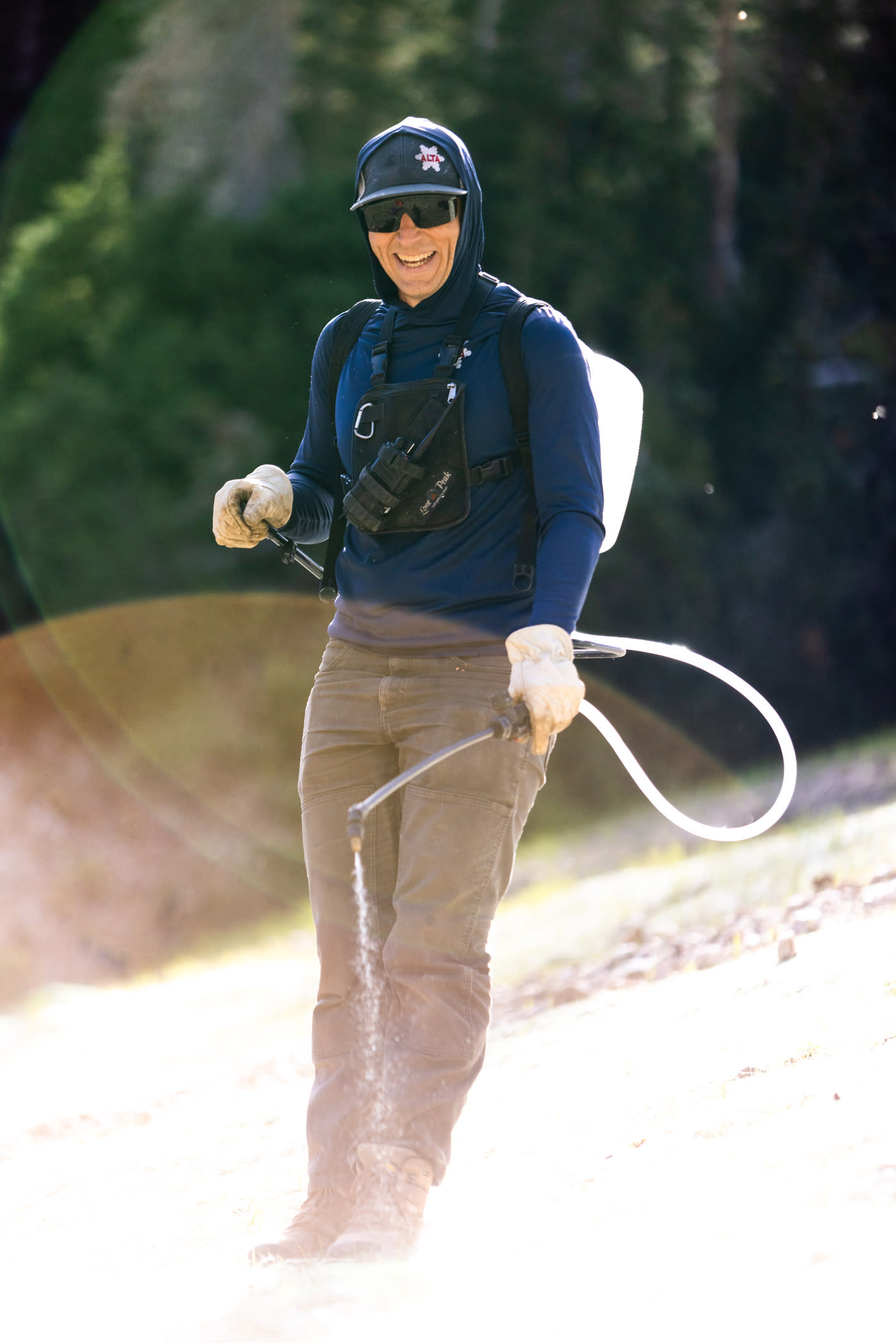
Alta employee, Andy Gishen, waters a freshly planted native grass seed mix. | Photo: Rocko Menzyk
Our team of five in the environmental center was responsible for putting the rest into the ground over the course of a few months. We will continue to add native plants for the next two summers and assess our revegetation plan after the third year. Once native vegetation takes hold in a majority of the disturbance area, the environmental center will move into a monitoring phase until it is deemed to be on the trajectory of recovery. Full recovery can take years, and our restoration team will continue to monitor these areas for natural vegetative cover and invasive species presence. A stormwater pollution prevention plan and best management practices were used to ensure that the project does not affect water quality in Little Cottonwood Creek. Best management practices are followed until a certified inspector clears that we have followed through with all necessary and established protocols to protect water quality and erosion, and all sediment control infrastructure can be removed from the site.
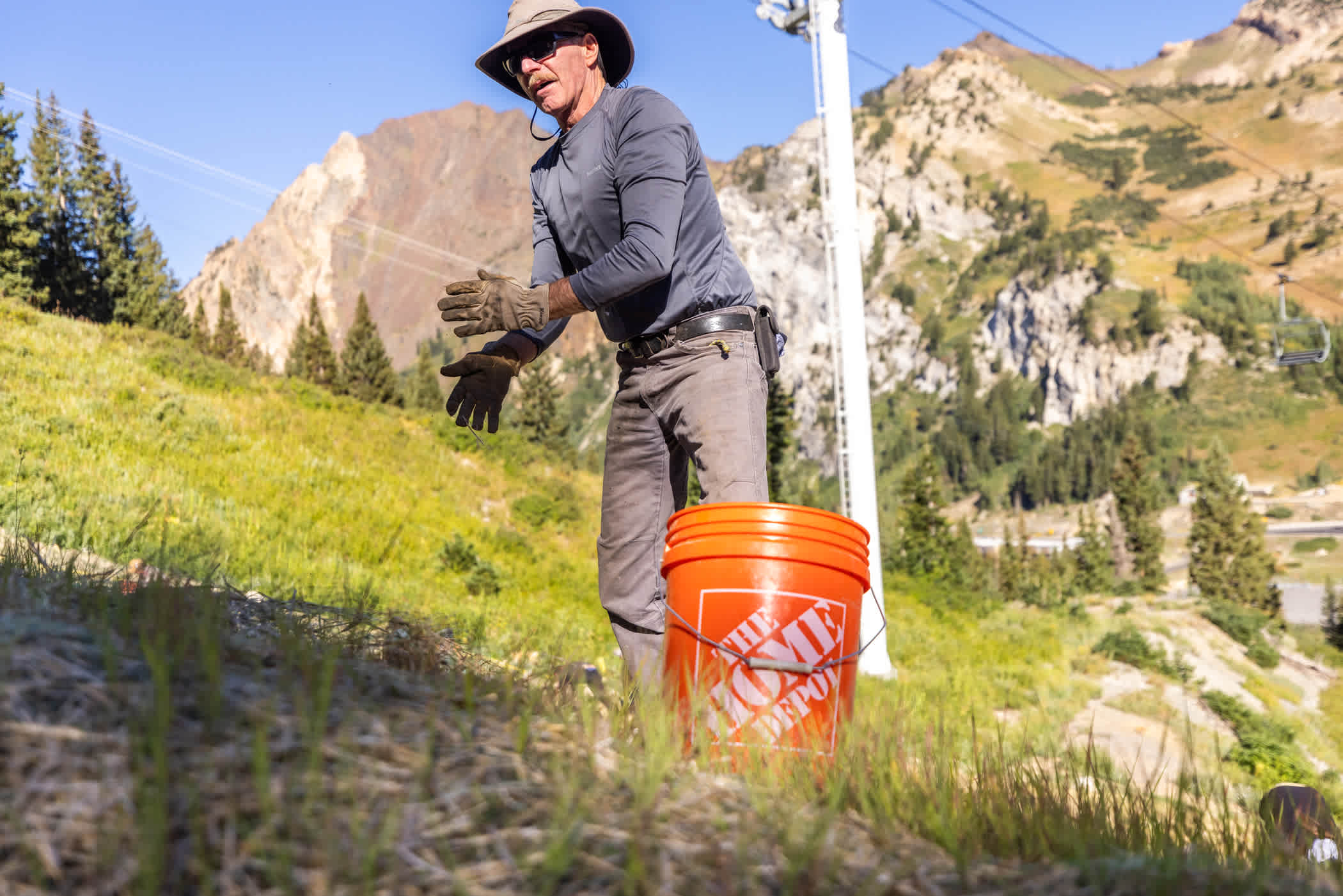
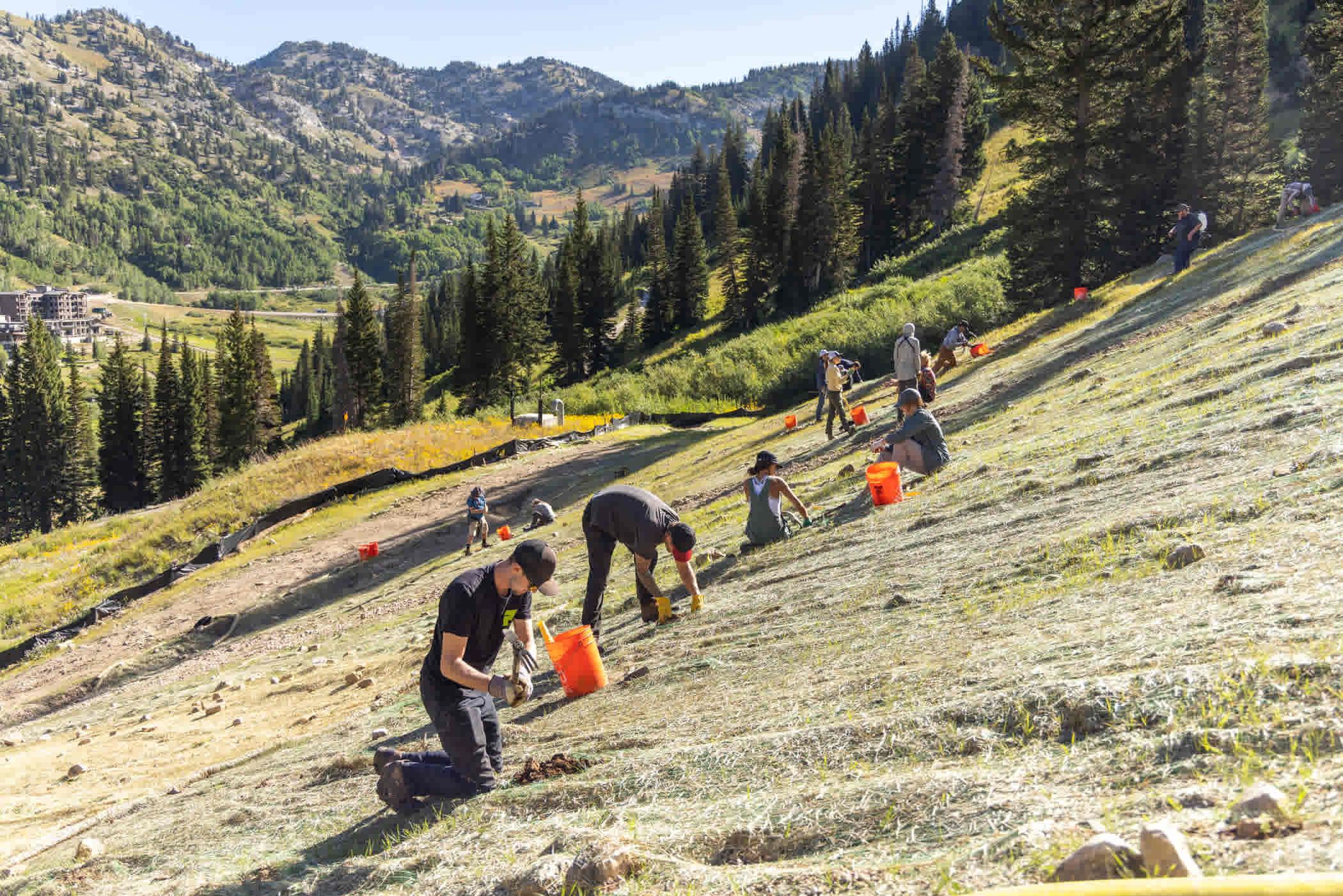
Employee Planting Day 3,280 plants were planted in the Nina's-Schuss project area in the summer of 2022. | Photo: Rocko Menzyk
WETLAND MITIGATION
What are wetlands?
Wetlands that occur at Alta Ski Area (ASA) are federally defined and protected areas that receive the frequent and prolonged presence of water at or near the soil surface. Wetlands at Alta present three primary characteristics: hydrology, hydric soils, and hydrophytic vegetation (USEPA, 2019). These areas are usually naturally occurring, and at times, are engineered when human disturbance has occurred.
The physical makeup of a wetland is integral to our watershed—they can receive runoff and remove pollutants through a myriad of physical, chemical, and biological processes.
Wetlands provide habitat for threatened and endangered species, like the Borreal Toad, found here at Alta. They also act as sponges, storing runoff, rain, and snow-melt to act as a braking system that slows flooding and reduces erosion. At times, ASA undertakes projects to make more efficient use of the resources within the ski area that unavoidably impact wetlands. When this happens, a strict protocol is followed to either preserve, minimize, or mitigate the permanent impact on wetlands. When a permanent impact is unavoidable, our obligation is to engineer compensation on the mountain to support wetland ecosystem characteristics.
In the summer of 2020, ASA made improvements to the Albion parking lot. It was determined that through this work, there would be permanent impacts to 2,178 square feet(sf) of wetland (.05 acres). To mitigate the loss, ASA developed and implemented a wetland mitigation plan.
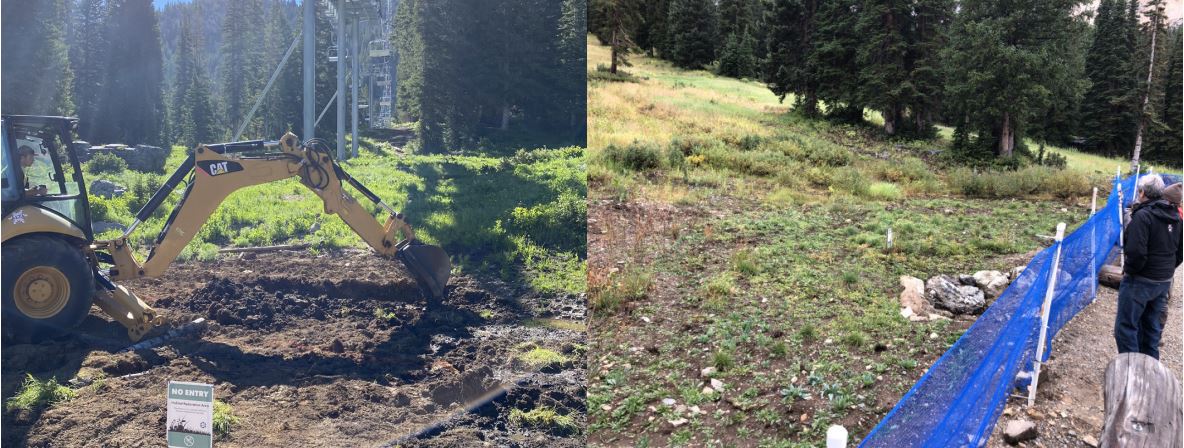
Left: Lightly excavating to mimic natural terrain contours and directing water to pool and deposit biomass. | Right: Progress after topsoil, native organic matter, vegetation transplants, and forbs planted.
Three areas were identified along or near the Albion Fen, a naturally existing wetland environment within the basin, where wetlands could be restored or established. A total of .18 acres were planned for, surpassing both the U.S. Forest Service and Salt Lake City Department of Public Utilities’ guidelines for mitigation. Each site presented its own terrain and hydrological conditions, however, the general project goal was to work with each site’s existing vegetation, elevation, and slope to establish wetland conditions. Bioengineering included lightly excavating areas to mimic natural terrain contours and directing water to pool and deposit biomass. Once this was deemed successful, the basins of the sites were lined with a mixture of topsoil, native organic matter, and peat moss. This laid the baseline work for the next phase: adjacent vegetation transplants, native forb planting, and seeding.
Native plant species, like willows (Salix sp.), Nebraska Sedge (Carex nebrascenis), Monkey flower (Mimulus sp.), and Mountain Bluebells (Mertensia ciliata) were carefully transplanted from neighboring terrain. Each site received approximately 50 of these transplants. Next, a total of 1500 native wildflowers and short forbs were planted amongst the three sites (500 each). The wildflowers and short forbs were sourced as seed from Alta the year before and grown locally, returning to Alta to be planted in restoration areas. Finally, a U.S. Forest Service-approved seed mix was sown into the soil.
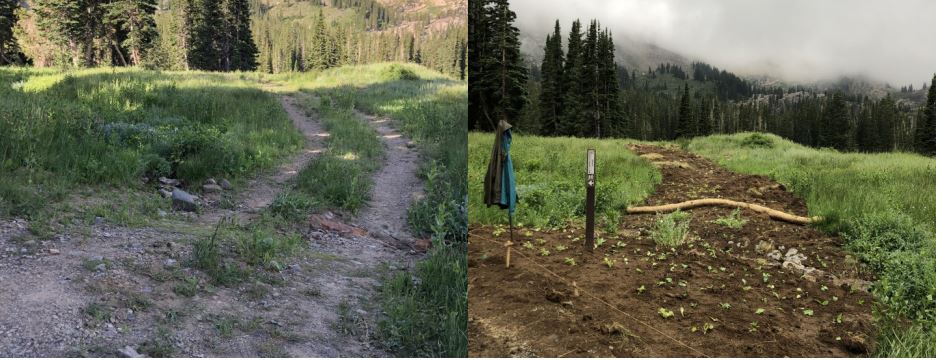
Left: Cecret Site before wetland conditions were established | Right: Cecret Site progress after wetland mitigation plan implemented
Once 1–3 years of active and aggressive planting is completed, the projects will continue into the monitoring phase. This is a vital component in supporting the success and documentation of a mitigation plan. Metrics and benchmarks to evaluate progress are used in Alta’s monitoring plan. Noxious, invasive, and non-native vegetation is monitored for presence in the sites and hand-pulled for treatment. Because these projects are in the first year of active planting, monitoring has been limited. A line survey was completed for each site, noting the species present in the summer of 2022. The USFS will work with ASA to evaluate and monitor the restoration work during the following three years.

Left: Berm Site before, June 2022. | Center: Berm removed, excavated materials used in other wetland sites, July 2022.| Right: Berm Site progress after wetland mitigation plan implemented, Sept 2022.
From the Alta Environmental Center’s perspective, we saw incredible success in growing native species and maintaining water in the recovered areas.
The natural recovery has been visibly successful, and we are looking forward to supporting the mitigation process as the years continue.

Alta Environmental Center’s mission is sustainability - our commitment is to protect and improve the well-being of Alta’s environment, ski industry, and community. In collaboration with our community partners, we provide opportunities for on-mountain restoration projects, education, and connection to the land. These enriching experiences provide a sense of responsibility and ownership to the natural environment here at Alta and intend to secure ecological prosperity for future generations to enjoy. During the summer of 2022, we hosted 20 stewardship and educational events and worked with over 400 volunteers to plant wildflowers, trees, and shrubs with our community.
COMMUNITY SNAPSHOT
This fall we had the chance to chat with a member of the Alta community, Wendy Stein, who has been an avid volunteer with the Alta Environmental Center (AEC). Wendy heard about the AEC back in 2016 after attending a volunteer event with Tree Utah, one of our partners. “I already loved spending time at Alta - especially in the summer - so it was an extra bonus to come up here and volunteer for restoration and revegetation projects.” Since then Wendy has joined us every summer for some of her favorite events including Tree Planting and Clean-Up Day, even embarking on her own solo trash clean-up mission on a summer day hiking near sugarbowl.
We discussed how spending time in Little Cottonwood Canyon has led her to feel a sense of protection and loyalty to this land. “Alta has been a special place for me in my adulthood, coming up to hike in the summer is where I feel like I have been able to grow and learn so much about myself. Being here on an early summer morning, with just my headlamp and no one around is a very calming and grounding feeling. It really feels like you have this whole place to yourself- plus it’s only an 8-mile drive up from the city.” Taking ownership and having a sense of loyalty to this land is the primary way we can ensure future generations will be able to enjoy the magic of Alta. Through AEC events Wendy learned that Alta used to be a mining town, leading to this area being extracted of its resources to the point where there was very little left to take.
“I didn’t realize how long the impacts of destroying something for one sole purpose can last. I have learned how the land can be returned to the place it once was, and I can take part in preserving and restoring it for future generations to enjoy.”
Working with the AEC helps Wendy feel like she has a small part in this large ecosystem, restoring the land to how it once was. She hopes Alta can continue to be conserved so that future generations will be able to enjoy this magical place just as she, and so many of us have been able to for these past 85 years.
TRAIL WORK
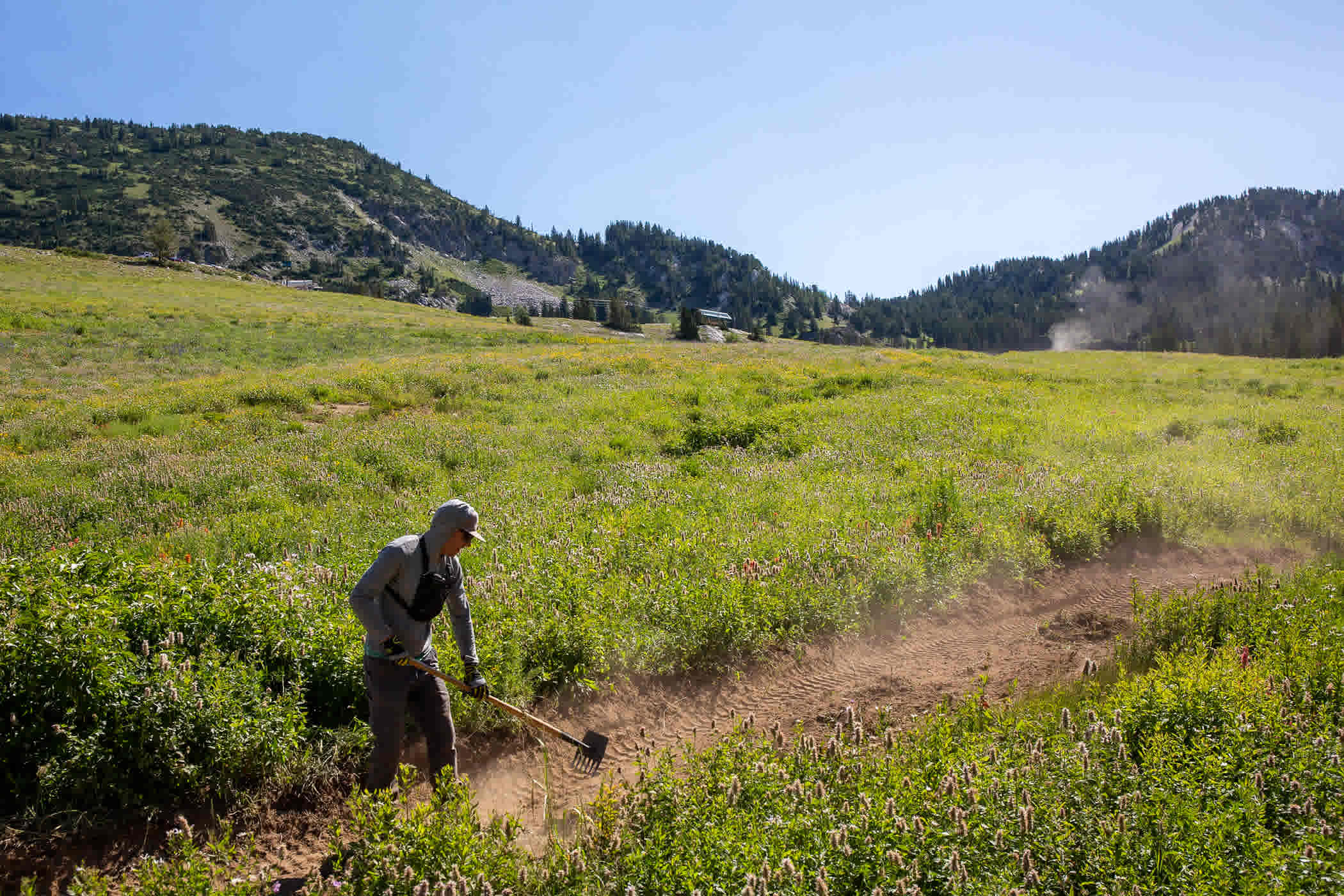
Alta Ski Area, in partnership with the U.S. Forest Service (USFS) and Cottonwood Canyons Foundation (CCF), manages the trail system within the ski area. As we are seeing increasing visitation - with 219,542 people visiting Alta this summer, 4x the amount in 2012 – the Alta Environmental Center (AEC) and its partners are tasked with creating a more sustainable and connected trail system. To meet this increasing demand, new trail standards were implemented over the summer of 2022. This summer’s trail improvements are intended to prevent damage to Alta’s plant communities and habitats, which is so often a pattern with increasing visitation. This work consisted of:
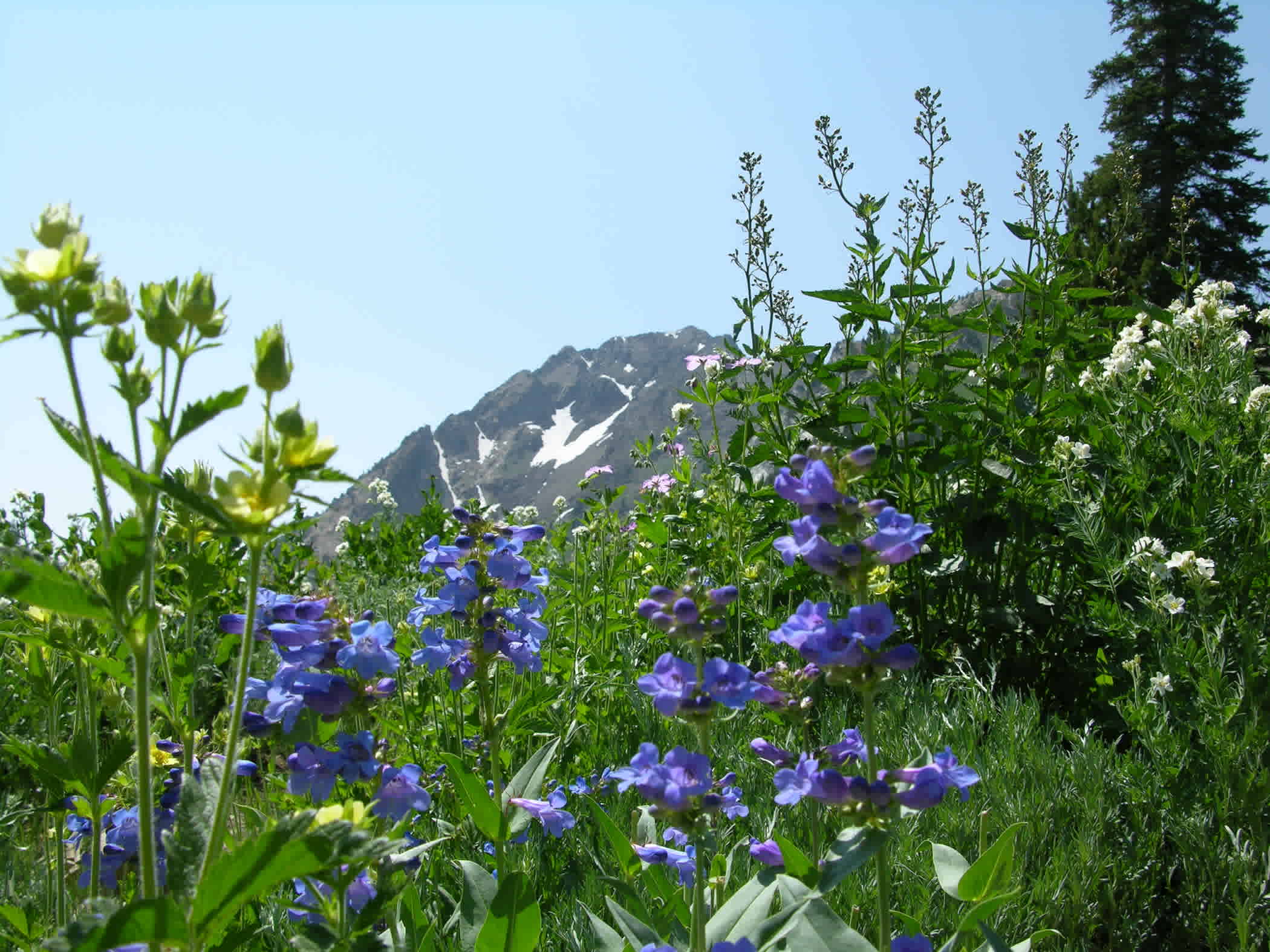
Wildflower Photo Pullouts
Looking for the perfect photo amongst the wildflowers? It’s easy! We have a photography pullout along the Albion Meadows Reroute that allows you to capture that “immersed in the flowers” image while protecting the beautiful wildflowers for future visitors. Look for signs that have a camera icon, and follow a short path to the landing. Have your subject stand on top of the green mats provided, while the photographer stays on the trail to frame up the shot. These pullouts were put in place to give hikers a place to capture the untouched, mountain beauty of Albion Basin while keeping them from actually stepping into untouched areas.
Rerouted Homerun Trail
This trail is no longer a straight path down the mountain. Switchbacks and berms were built to prevent erosion and aid with drainage. The previous trail’s contour caused water to flow down the vertical path, taking soil with it and deepening ruts. This led to erosion and caused small, but infrequent mudslides. The trail now gently winds through Albion Meadows, creating a friendlier grade for hikers.
Rope Line Along Trails
This season the AEC put in rope lines along most trails within the ski area to help hikers and bikers stay on the trail. The visual element of the rope line guides recreationists to the intended route and prevents the creation of unsustainable
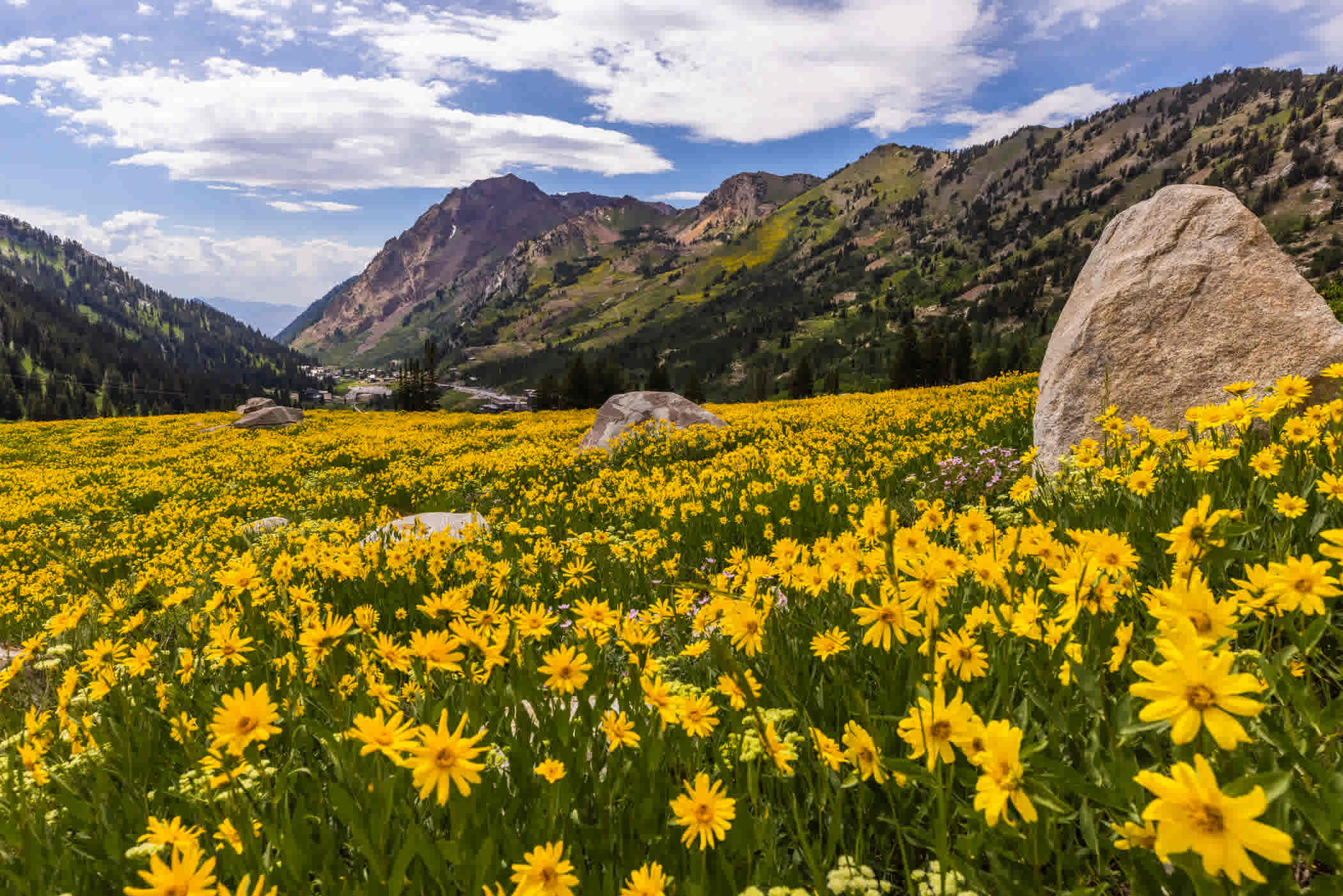
trail networks. These unwanted networks cause damage to the alpine flora, detriment to the soil stability, and harmful impacts to the watershed.
Tree Removal
Alta’s forest health management is an ongoing and dynamic process. Each summer season we work with a USFS Forest Health Protection Specialist to manage Alta’s forest resources. After field assessments are conducted and management recommendations from the Forest Service are in, the work begins. We first focus on diseased, damaged, or hazardous trees. Then we focus on trees that may need to be removed for construction purposes. If it is deemed necessary by the USFS, stands of trees are considered for thinning to regulate stand density. The desired outcome is to restore a more natural forest structure. Thinning creates an environment for more available growing space, relieving tree stress and competition for resources in forested areas that are susceptible to disease and insects, such as the western balsam bark beetle (Dryocoetes confucius). These threats can have devastating impacts on Alta’s forest health. Overall, practices like this result in a healthier and more vigorous forest.

Alta’s summer visitation has seen a trend in rising popularity. Managing this increase in visitation has its set of challenges - whilst providing an opportunity for the Alta Environmental Center to promote stewardship and education to those recreating throughout Alta. Below is a rundown of Alta’s visitation:
Summer Visitation
- This summer was Alta’s fifth season managing Summer Road Operations.
- The summer road was open for vehicles from Friday, July 1, 2022, through Monday, October 10, 2022. A total of 102 days for visitors to drive the Summer Road into Albion Basin.
- Based on vehicle counts at the Summer Fee Booth, an estimated total of 55,230 people visited the Albion Basin via the Summer Road during the summer of 2022. This estimate is calculated at 2.5 people per vehicle.
Alta Visitation
- Based on vehicle counts in the Town of Alta, a total estimate of 219,542 people visited Alta during the Summer 2022 season. That’s 4x the number of visitors we saw a decade ago during the summer of 2012.
Visitor Engagement and Management
- Representatives from the U.S. Forest Service, Alta Ski Area, Friends of Alta, and Cottonwood Canyons Foundation were present during weekends and holidays to engage with visitors.
- The primary discussion topics this summer were trail information & Naturalist information (wildflowers/wildlife).
- A total count of 6,233 visitors were engaged during the 2022 summer by our summer Naturalists. Key discussion topics included: How to protect the watershed, Trail Etiquette, Naturalist Information- Flora and Fauna specific to the area.
Albion Basin Campground
- The Albion Basin Campground was open for 77 days.
- The Campground switched all sites to reservation only from July 15, 2022 – September 10, 2022.
- Walk-up camping was available from July 1, 2022 – July 15, 2022 and September 11, 2022 – September 17, 2022.
SUMMER EDUCATION AND EVENTS
Alta Birding Hikes
In partnership with Tracy Aviary, monthly bird survey tours were held at Alta from May–October. The event involved a guided hike with a conservation ecologist from Tracy Aviary. Throughout the tour, countless feathered creatures are pointed out in the trees, bushes, and sky that are often missed at first glance. Individual bird tunes that fill the air are also identified - educating participants on what to listen and look for when out exploring in the mountains.
HawkWatch Bird Shows
Throughout the summer Hawkwatch International comes up to Alta and puts on a monthly Hawkwatch show followed by a naturalist-led hike. Participants learn about different species of birds and are led on a hike with one of our partner organizations around Albion Basin.
TreeUtah Harvest and Restoration
Volunteers join the AEC and Tree Utah as we harvest saplings that have grown in Alta’s ski runs. The small native tree saplings are removed and taken to an on-site nursery where they will be later transplanted to a safer place on the mountain over the summer.
Community Volunteer Days
Community members of Alta join the AEC in doing restoration work on the mountain, trail work, and weed pulling and planting. This event helps tackle noxious, invasive weeds and makes room for the native wildflowers to grow.
Employee Conservation Day
The AEC held two Employee Conservation Days to enlist the help of 20-30 employees across multiple departments to dig holes and plant seedlings on Nina’s. This project helped revegetate and restore an area that was regraded during the summer of 2021. Over the two days, we planted 3,280 native seedlings.
Kid’s Day
Alongside our partner and community organizations, we participated in a fun-filled educational day at Alta. Booths from every organization were set up with an array of kid-friendly activities for all ages to enjoy. Topics covered included the watershed, Leave No Trace, and wildlife and native plants that can all be found here in Little Cottonwood Canyon. The purpose of this event is to get kids engaged within a natural environment in an educational and fun manner.
Wasatch Wildflower Festival
An event hosted at Alta once throughout the summer, it entails educated, volunteer naturalists from the Cottonwood Canyons Foundation leading hikes throughout the breathtaking wildflowers in Albion Basin. Participants learn about the principles of stewardship, the importance of protecting the watershed, and celebrate the beauty and diversity of the wildflowers in the Wasatch mountains and how we can all take part in protecting this unique ecosystem. This annual event is one of the largest of the summer and fun for people of all ages.
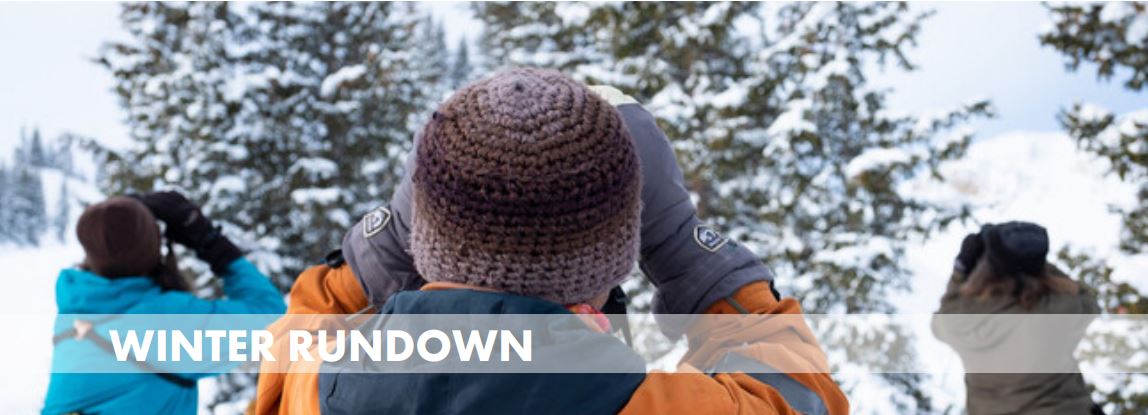
Investing in the stewardship of the air, land, and water of Little Cottonwood Canyon is a cornerstone in the Alta Environmental Center’s (AEC) mission statement. Our skiers and community look to us to be stewards of the private and public lands on which we operate. The AEC works year-round to act as a resource for our community in promoting sustainable initiatives through partnerships, education events, and stewardship opportunities. Our winter programs provide an educational space for participants in an outdoor setting, exploring how we can connect skiing with conserving what lies beneath the layer of snowpack and why protecting this unique mountain environment is important.
In partnership with the Tracy Aviary, our twice-monthly bird tours help connect skiing with the environment. Bryant Olsen and Tim Brown, conservation ecologists from Tracy Aviary, lead these educational tours. Participants are guided around the mountain, engaged in observing bird behavior, and learning about the natural environment. Understanding how the 100 different species of birds that live in Little Cottonwood Canyon play a role in this ecosystem as pollinators, seed dispersers, and ecosystem engineers helps us connect with our community on why it is so important to conserve their habitat. The tours will continue this winter, starting in January on every second and fourth Thursday. Please check our website for registration.
Snowshoeing is an inclusive activity that allows Alta visitors an opportunity to explore this environment without skis. We partner with the Cottonwood Canyons Foundation (CCF) on this event, and they truly bring it to life. CCF has trained and educated naturalists that come up to lead the tours and provide a thoughtful and engaging experience on wildlife that inhabit this canyon, tree species that are found in this high-alpine environment, and the geological history of Little Cottonwood Canyon and Alta. Tours will be monthly on every third Friday starting January 20. Please go to our website to register.
These family-friendly tours are offered through our partnership with the Cottonwood Canyons Foundation (CCF). Geared towards all ages and ski abilities, this tour takes participants on a fun and informative experience, learning about the geology, history, watershed, and winter ecology of the Cottonwood Canyons. Tours are offered every Saturday starting January 14.
This program is for all ages and ski abilities. In partnership with Tree Utah, the tours are led by Ian Peisner, one of Tree Utah’s arborists. Participants are led on an exploratory tour of the forest and tree species that survive in these extreme, high-alpine environments. Throughout the tour, we are able to connect the ecology of Alta’s forest with the efforts the Alta Environmental Center and our partners implement to promote a healthy forest. This year tours are offered twice a month! Starting in January on the first and third Thursday of each month.
Ske-cology is a program the Alta Environmental Center (AEC) piloted in partnership with the U.S. Forest Service and Vail Mountain Resort. This outdoor education program engages children of all ages in a form of organized learning that takes place outdoors, inspiring curiosity about the mountain environment while skiing. Ten signs were set out by the AEC in a hide-and-seek type course, engaging kids to keep their eyes out for the signs along our Sunnyside and Albion lift runs. The program highlights local mountain ecology, wildlife, conservation, watershed protection, and Leave No Trace principles. These signs are located on two beginner runs in the winter, and the primary, beginner hiking trail in the summer. Ske-cology supports the Alta Environmental Center’s commitment to providing environmental education as a way to engage with the natural environment, turning these outdoor spaces into a multi-subject, educational and fun experience at Alta.
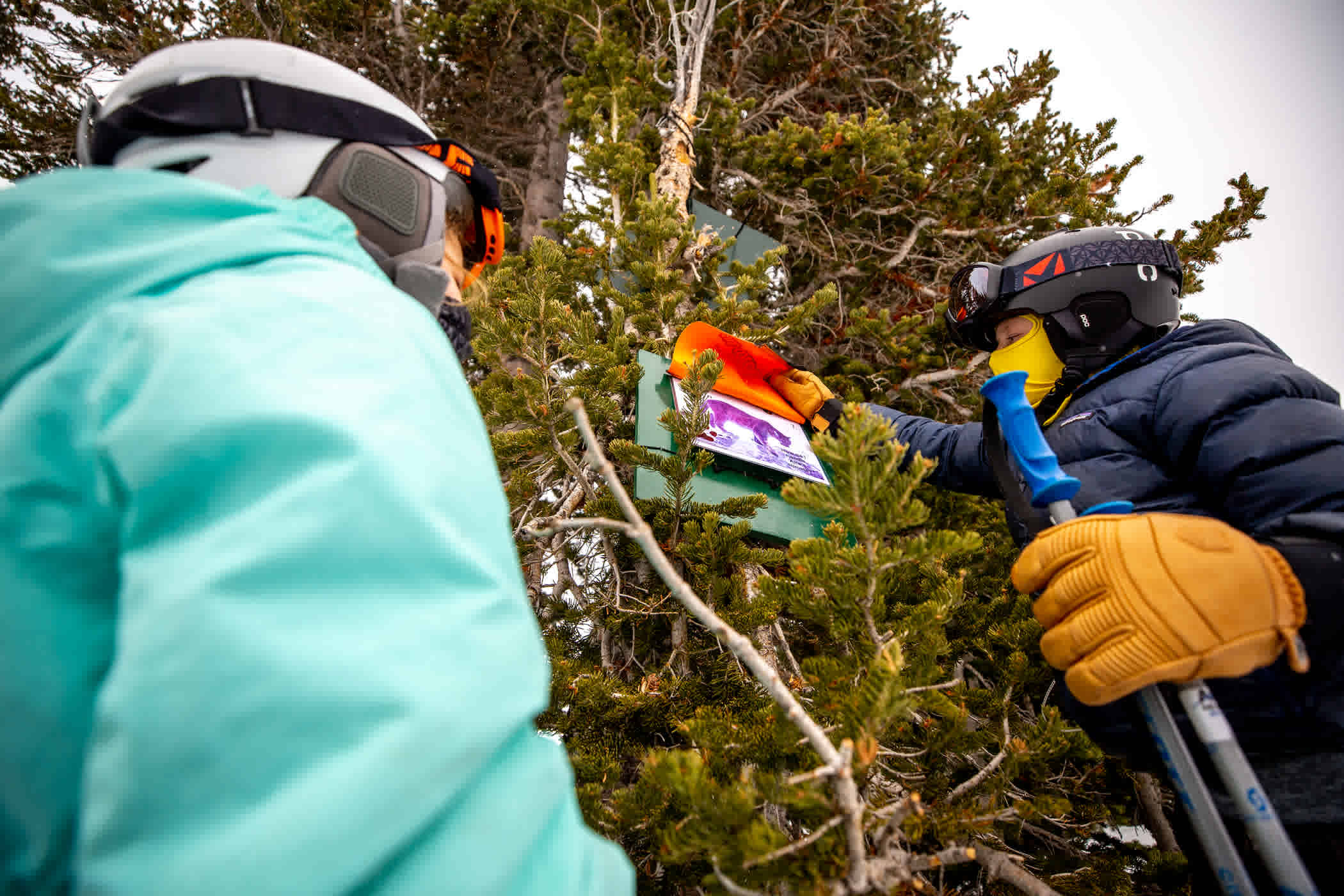
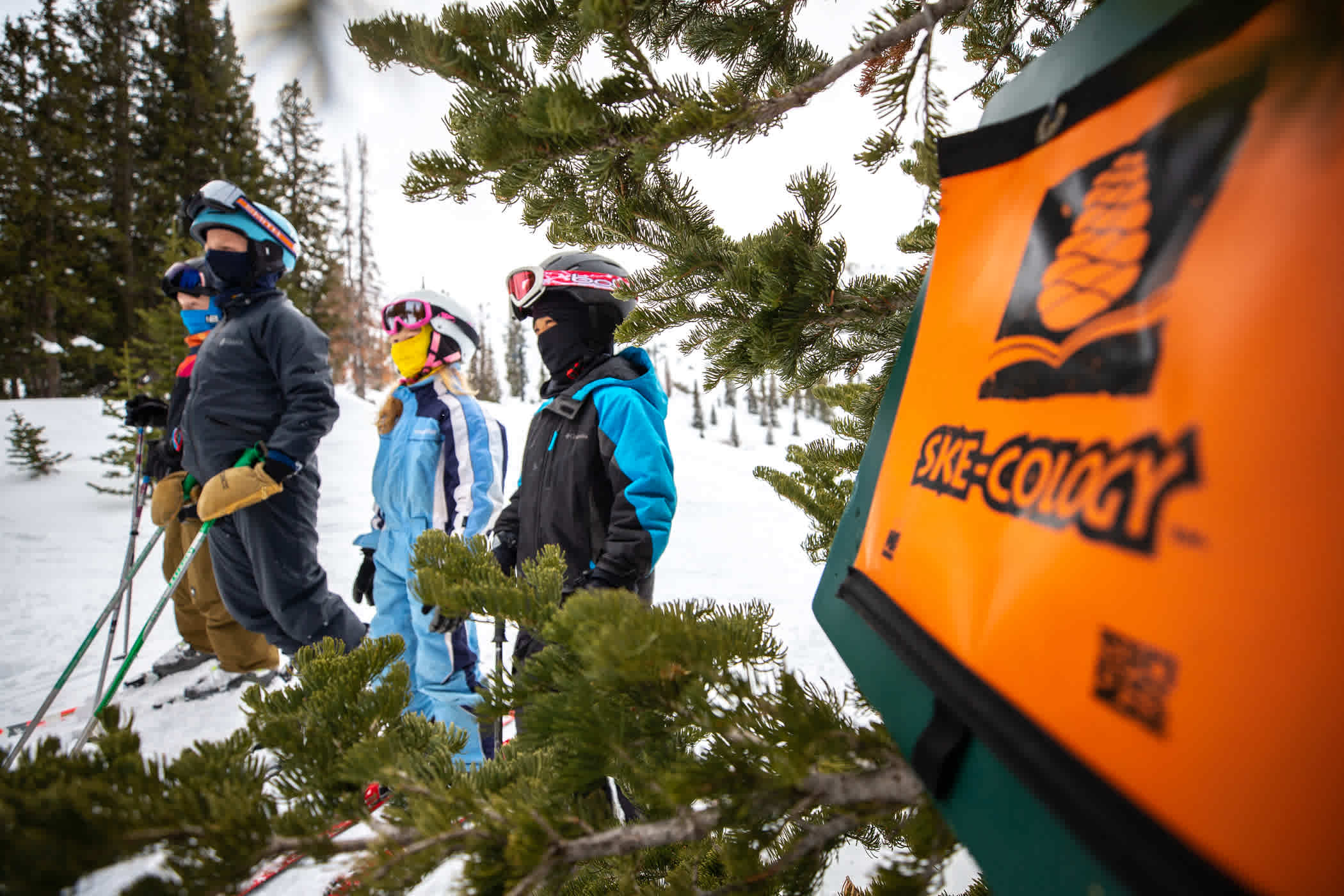
Kids discovering Ske-cology signs hidden in the trees off the Sunnyside and Albion lift runs. | Photo: Rocko Menzyk
A New Director
Hello! My name is Jennifer Melton and I am in my fourth year working for the Alta Environmental Center. I was fortunate enough to work alongside both of my predecessors, Maura Olivos and Beth Yetter, as their outreach coordinator during their tenure. I have worked in Little Cottonwood Canyon for five years and have been completely enchanted by Alta’s environment and community. Leading our organization here in LCC has been one of my greatest pleasures so far. I am looking forward to a lifetime of learning. A few partnerships our team is currently involved with include non-profit environmental organizations, the Town of Alta, the U.S. Forest Service, and Salt Lake City Public Utilities to ensure that resources are protected where we share common interests. It is our intent to protect not only these resources but to ensure prosperity for our community, environment, and economy. Together, these efforts will maintain the same beauty and abundance we know now for many years to come. In the winter, you will likely see me birding with Tracy Aviary or skiing through the trees with TreeUtah. In the summer, you will find me in the meadows or corners of the mountain working with our conservation staff on vegetation management. Stop and say hello, and keep an eye on our Events Calendar to see how you can get involved if you feel so inspired. Cheers!
Golden Eagle Award 2022
Alta’s commitment to purchase renewable energy credits (RECs) and a food waste diversion program, coupled with an ongoing commitment to sustainability and environmental performance led the National Ski Areas Association (NSAA) to award Alta the highest environmental honor in the ski industry: the 2022 Golden Eagle Award for Overall Environmental Excellence. This prestigious award is presented annually to a North American ski area based on its environmental performance and stewardship. Congratulations to the Alta Environmental Center which plays an instrumental role in Alta’s sustainability and environmental efforts and all Alta employees and community partners who support Alta’s ongoing environmental efforts and dedication.
Food Waste Collection Program
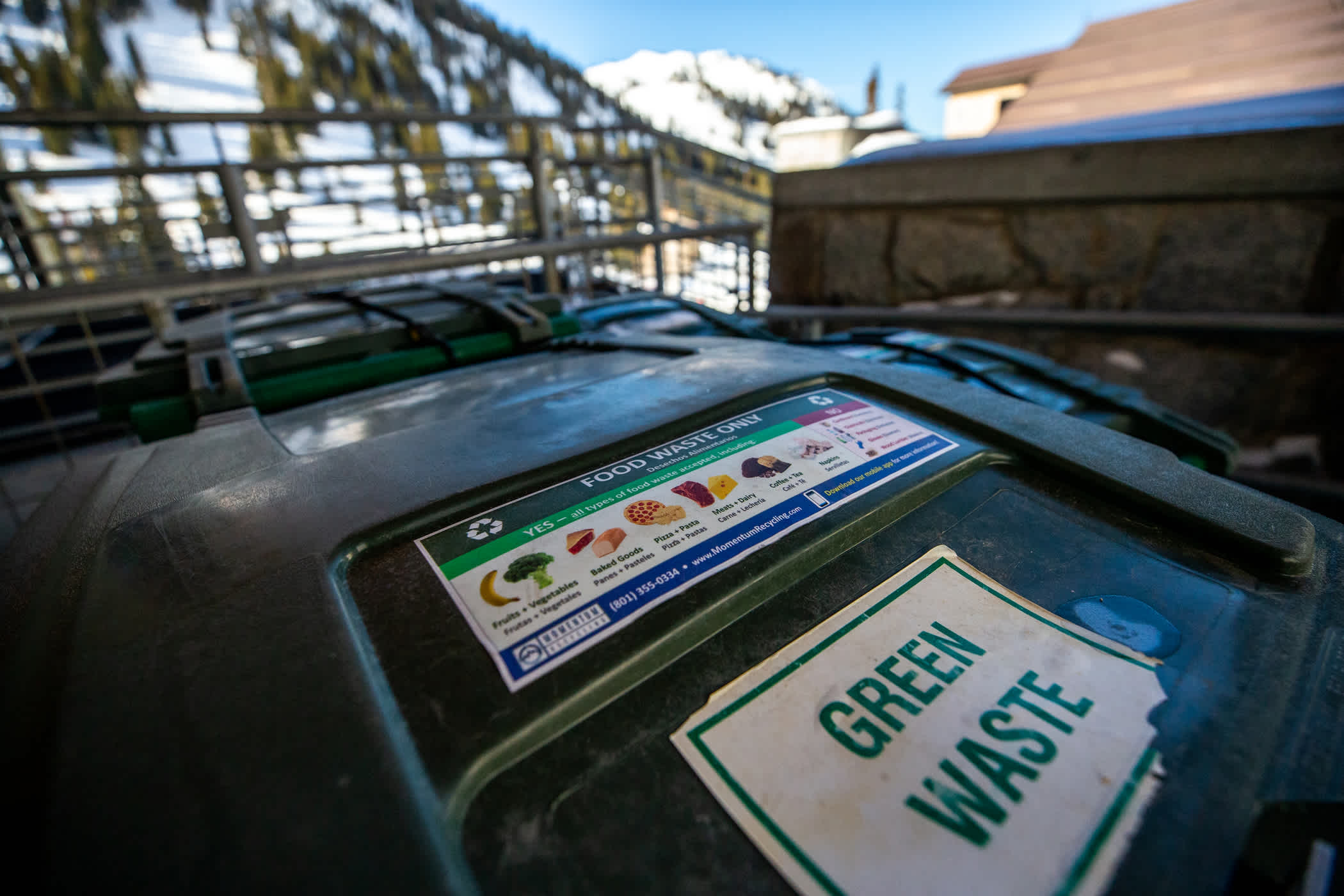 Alta Ski Area began its Food Waste Collection Program in the spring of 2019. Starting small with a two-month pilot program, five kitchens in the ski area (Buckhorn employee kitchen, Alf’s, Watson Shelter, Albion Grill, and Collins Grill) participated by collecting food waste, and then personally driving the waste down canyon to a compost facility. Although the pilot program helped divert food waste from entering the landfill, we found inefficiencies in this process. In 2020, COVID-19 circumstances also put a wrench in things and the program was unable to run. In the spring of 2021, a second program was piloted, and this time Alta looked for a more permanent and effective collection program. Partnering with Snowbird—a neighboring ski area in Little Cottonwood Canyon—Alta has coordinated to use Momentum Recycling Solutions to transport food waste down canyon and to Wasatch Resource Recovery, the home of a large-scale food digester. Here, food waste is processed and produces two results: natural gas used to heat homes and nutrient-rich fertilizer that can be used in farming and gardening practices, resulting in a zero-waste process.
Alta Ski Area began its Food Waste Collection Program in the spring of 2019. Starting small with a two-month pilot program, five kitchens in the ski area (Buckhorn employee kitchen, Alf’s, Watson Shelter, Albion Grill, and Collins Grill) participated by collecting food waste, and then personally driving the waste down canyon to a compost facility. Although the pilot program helped divert food waste from entering the landfill, we found inefficiencies in this process. In 2020, COVID-19 circumstances also put a wrench in things and the program was unable to run. In the spring of 2021, a second program was piloted, and this time Alta looked for a more permanent and effective collection program. Partnering with Snowbird—a neighboring ski area in Little Cottonwood Canyon—Alta has coordinated to use Momentum Recycling Solutions to transport food waste down canyon and to Wasatch Resource Recovery, the home of a large-scale food digester. Here, food waste is processed and produces two results: natural gas used to heat homes and nutrient-rich fertilizer that can be used in farming and gardening practices, resulting in a zero-waste process.
To date, Alta Ski Area has diverted 28.75 tons of food from entering landfills. That’s the equivalent of 57,493.75 pounds of food being composted into nutrient-rich fertilizer
Why is this important?
When food waste decomposes in an open environment, like your garden, microorganisms eat the organic material and break it down through an aerobic (oxygen-rich) process. During this, a small amount of carbon dioxide is released. In contrast, when food waste enters the landfill it is buried underneath layers of inorganic waste. It is trapped in anaerobic (absent of oxygen) conditions, where bacteria breaks down the waste, and methane is the byproduct of this process. Both carbon dioxide and methane are greenhouse gases, however, methane is highly effective at trapping heat in the atmosphere, acting like a thick blanket over the Earth. According to the Environmental Protection Agency (EPA), methane is 80 times more effective at warming the atmosphere than carbon dioxide within a 20-year period. The impacts of different gases on global warming is defined through a metrics system called the Global Warming Potential (GWP). The GWP is a measure of how potent a greenhouse gas is and how long it will remain active in the atmosphere, with methane having a much more harmful GWP than Carbon Dioxide over a 100- year period (Understanding Global Warming Potentials 2022). As a ski area with an interest in maintaining consistent temperatures, our intention with this program is to continue finding ways to lessen our impact and reduce greenhouse gas emissions.

Renewable Energy Credits
As a business that relies on snow, Alta Ski Area recognizes the impacts and challenges posed by climate change. Electricity makes up for more than 50% of the ski area’s annual greenhouse gas emissions.
Faced with the challenge of reducing our carbon footprint, the ski area announced that it is committed to matching 100% of its annual electricity use with renewable energy credits (RECs), beginning in January of 2022.
By matching the annual electricity use through the purchasing of RECs, it is estimated that the ski area will offset its carbon footprint by 3,547 metric tons of carbon dioxide per year. RECs are non-tangible, tradeable energy commodities that represent energy generated by renewable energy sources, such as solar or wind power. In the electric power grid, electricity from many different sources mixes together and there is no way to distinguish the exact source that your electricity is coming from. This is how RECs come into play, as they represent a specific amount of electricity produced and delivered by a renewable source, such as wind or solar power. For every megawatt hour of electricity produced by a renewable resource, a REC is generated that the wind or solar power facility can sell. Buying these credits allows Alta Ski Area to acknowledge that the electricity we use comes from a renewable resource with low to zero emissions. RECs are uniquely numbered and can be tracked, therefore they are a credible way to buy and sell renewable electricity, and once bought they cannot be resold. The RECs Alta Ski Area purchases are through Rocky Mountain Power’s Blue Sky program, which is Green-E Energy certified by the Center for Resource Solutions. Alta will continue to look for solutions that directly benefit our environment, and support future opportunities for positive change.
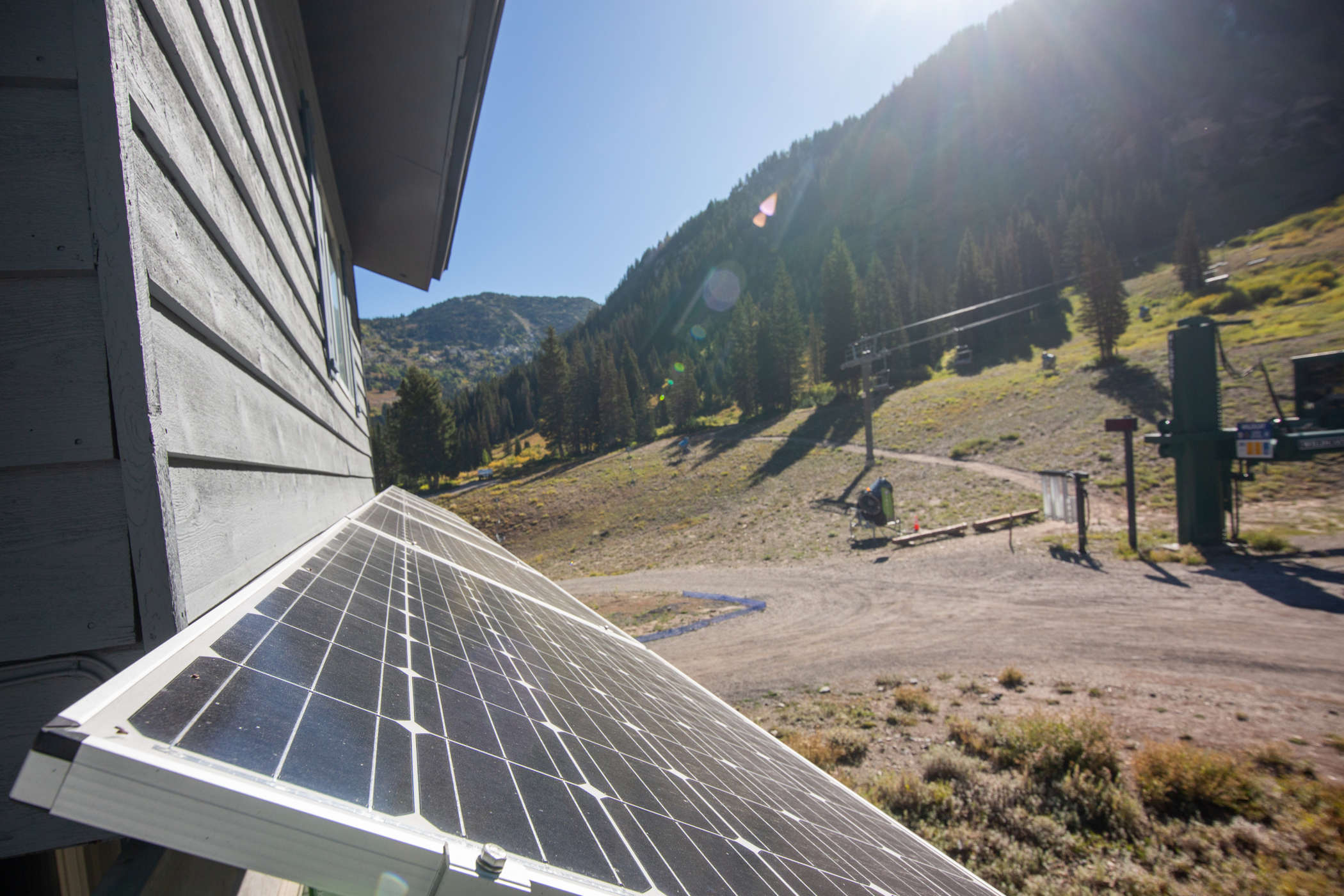
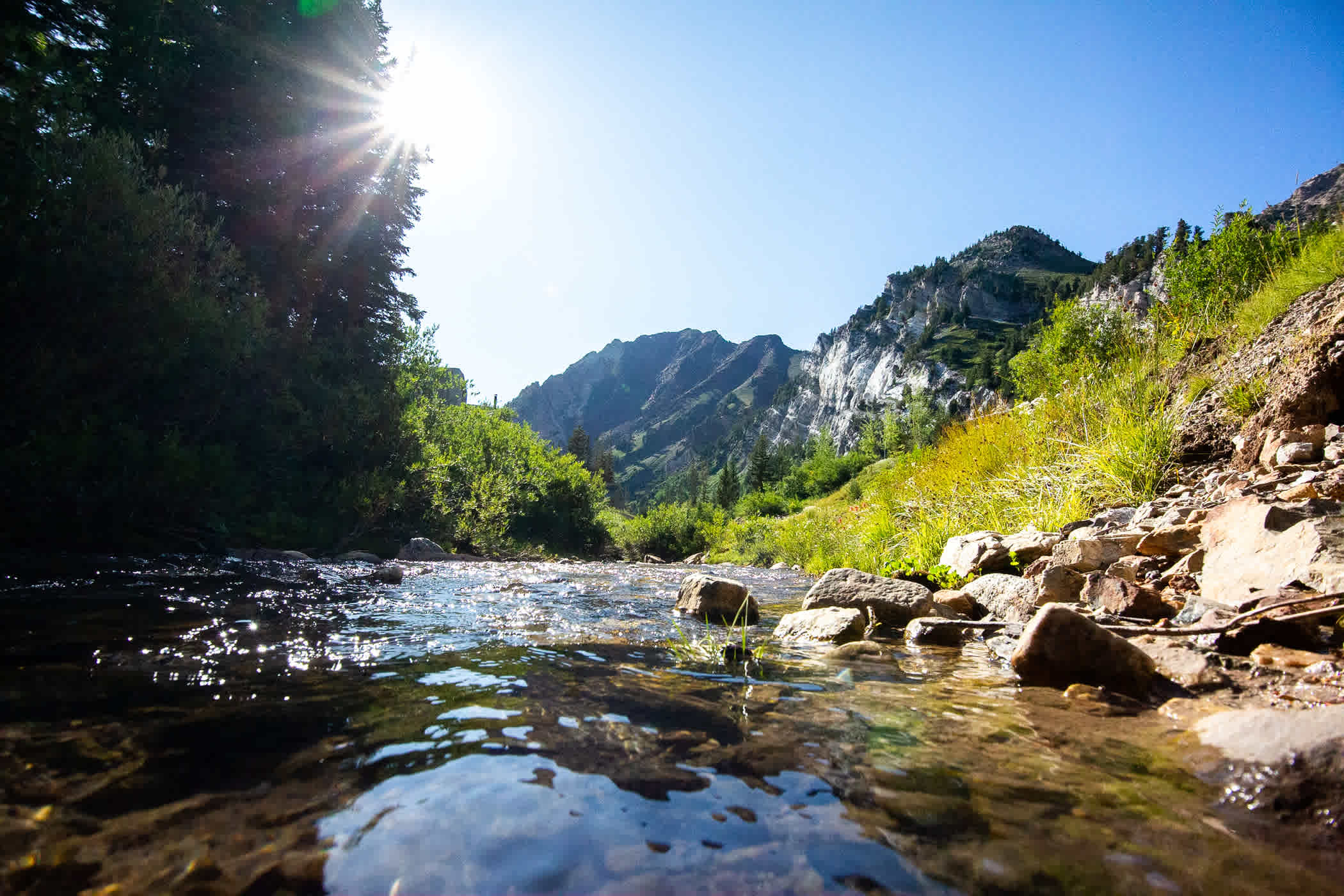
Little Cottonwood Creek and solar panels on the Buckhorn | Photos: Rocko Menzyk

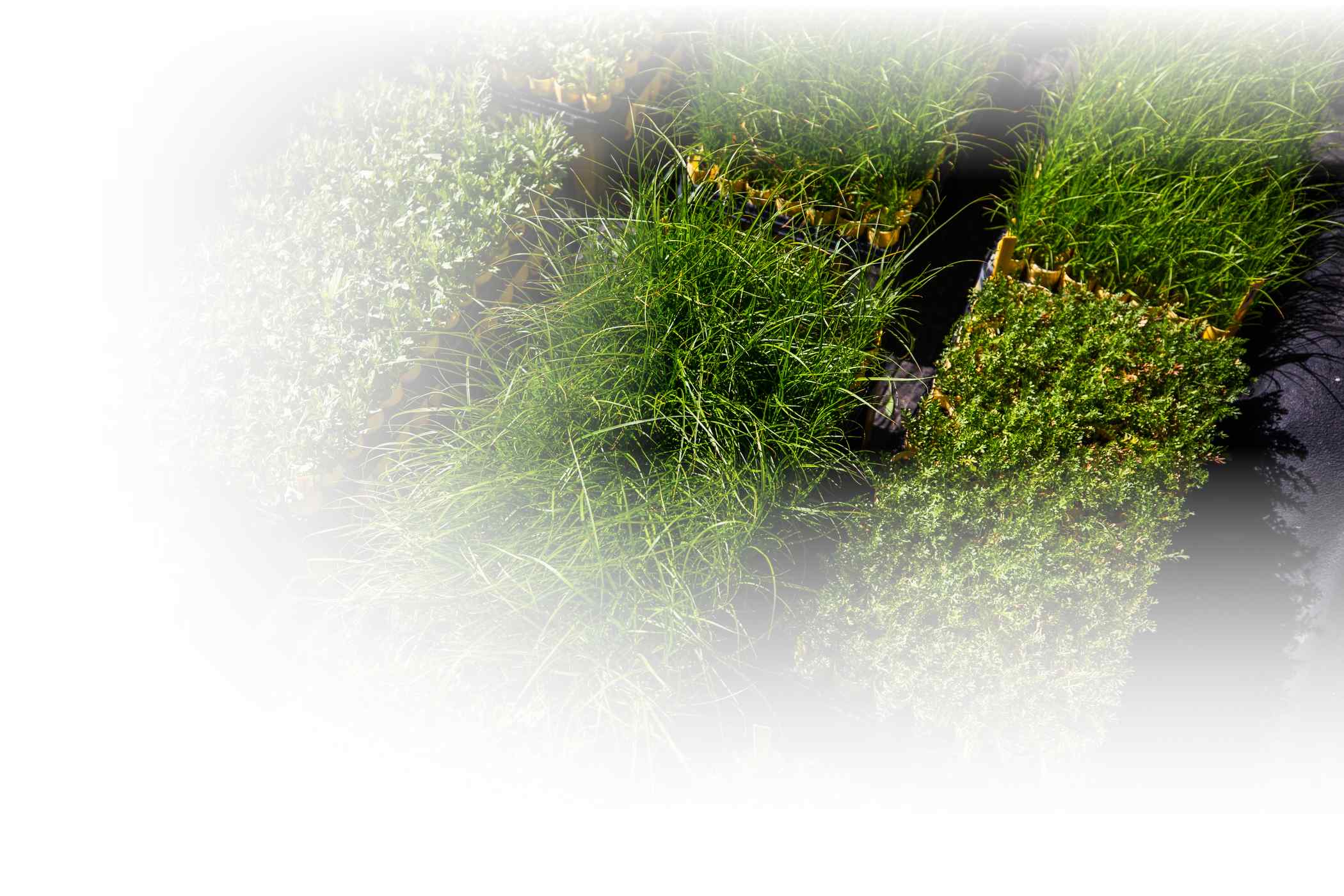

Comments